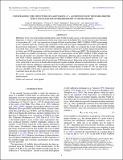CONSTRAINING THE STRUCTURE OF SAGITTARIUS A*'s ACCRETION FLOW WITH MILLIMETER VERY LONG BASELINE INTERFEROMETRY CLOSURE PHASES
Author(s)
Broderick, Avery E.; Fish, Vincent L.; Doeleman, Sheperd Samuel; Loeb, Abraham
DownloadBroderick-2011-CONSTRAINING THE STR.pdf (949.2Kb)
PUBLISHER_POLICY
Publisher Policy
Article is made available in accordance with the publisher's policy and may be subject to US copyright law. Please refer to the publisher's site for terms of use.
Terms of use
Metadata
Show full item recordAbstract
Millimeter wave very long baseline interferometry (mm-VLBI) provides access to the emission region surrounding Sagittarius A* (Sgr A*), the supermassive black hole at the center of the Milky Way, on sub-horizon scales. Recently, a closure phase of 0° ± 40° was reported on a triangle of Earth-sized baselines (SMT-CARMA-JCMT) representing a new constraint upon the structure and orientation of the emission region, independent from those provided by the previously measured 1.3 mm-VLBI visibility amplitudes alone. Here, we compare this to the closure phases associated with a class of physically motivated, radiatively inefficient accretion flow models and present predictions for future mm-VLBI experiments with the developing Event Horizon Telescope (EHT). We find that the accretion flow models are capable of producing a wide variety of closure phases on the SMT-CARMA-JCMT triangle and thus not all models are consistent with the recent observations. However, those models that reproduce the 1.3 mm-VLBI visibility amplitudes overwhelmingly have SMT-CARMA-JCMT closure phases between ±30°, and are therefore broadly consistent with all current mm-VLBI observations. Improving station sensitivity by factors of a few, achievable by increases in bandwidth and phasing together multiple antennas at individual sites, should result in physically relevant additional constraints upon the model parameters and eliminate the current 180° ambiguity on the source orientation. When additional stations are included, closure phases of order 45°-90° are typical. In all cases, the EHT will be able to measure these with sufficient precision to produce dramatic improvements in the constraints upon the spin of Sgr A*.
Date issued
2011-09Department
Haystack ObservatoryJournal
Astrophysical Journal
Publisher
Institute of Physics/American Astronomical Society
Citation
Broderick, Avery E., Vincent L. Fish, Sheperd S. Doeleman, and Abraham Loeb. “CONSTRAINING THE STRUCTURE OF SAGITTARIUS A*’s ACCRETION FLOW WITH MILLIMETER VERY LONG BASELINE INTERFEROMETRY CLOSURE PHASES.” The Astrophysical Journal 738, no. 1 (August 10, 2011): 38. © 2011 American Astronomical Society.
Version: Final published version
ISSN
0004-637X
1538-4357